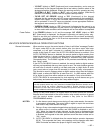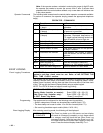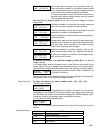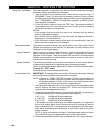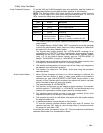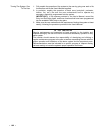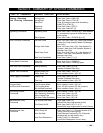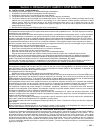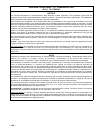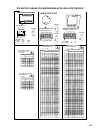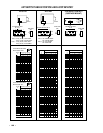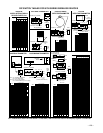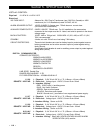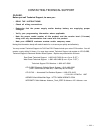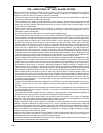
Ð 105 Ð
Section 4. REGULATORY AGENCY STATEMENTS
UL INSTALLATION REQUIREMENTS
The following requirements apply to UL Residential Burglary installations:
1. All partitions must be owned and managed by the same person(s).
2. All partitions must be part of one building at one street address.
3. The audible alarm device(s) must be placed where it/they can be heard by all partitions.
4. The Control cabinet must be protected from unauthorized access. This can be done by installing a tamper switch on the
cabinet door (not supplied with VISTA-40) or by installing a UL Listed passive infrared detector positioned to detect
cabinet access. Wire the selected device to any EOLR supervised zone (zone 1-8). Program this zone for day
trouble/night alarm (type 05) or 24 hour audible alarm (type 07) response. The 24 hour alarm response must be used for
multiple partitioned systems.
5. Remote Downloading and auto-disarming are not UL Listed features.
FEDERAL COMMUNICATIONS COMMISSION (FCC) STATEMENT
This equipment has been tested to FCC requirements and has been found acceptable for use. The FCC requires the following
statement for your information:
This equipment generates and uses radio frequency energy and if not installed and used properly, that is, in strict accordance
with the manufacturer's instructions, may cause interference to radio and television reception. It has been type tested and
found to comply with the limits for a Class B computing device in accordance with the specifications in Part 15 of FCC Rules,
which are designed to provide reasonable protection against such interference in a residential installation. However, there is
no guarantee that interference will not occur in a particular installation. If this equipment does cause interference to radio or
television reception, which can be determined by turning the equipment off and on, the user is encouraged to try to correct the
interference by one or more of the following measures:
¥ If using an indoor antenna, have a quality outdoor antenna installed.
¥ Reorient the receiving antenna until interference is reduced or eliminated.
¥ Move the receiver away from the control/communicator.
¥ Move the antenna leads away from any wire runs to the control/communicator.
¥ Plug the control/communicator into a different outlet so that it and the receiver are on different branch circuits.
If necessary, the user should consult the dealer or an experienced radio/television technician for additional suggestions.
The user or installer may find the "Interference Handbook" booklet prepared by the Federal Communications Commission
helpful. This booklet is available from the U.S. Government Printing Office, Washington, DC 20402.
The user shall not make any changes or modifications to the equipment unless authorized by the Installation Instructions or
User's Manual. Unauthorized changes or modifications could void the user's authority to operate the equipment.
FCC PART 68 NOTICE
This equipment complies with Part 68 of the FCC rules. On the front cover of this equipment is a label that contains, among
other information, the FCC registration number and ringer equivalence number (REN) for this equipment. If requested, this
information must be provided to the telephone company.
This equipment uses the following jacks:
An RJ31X is used to connect this equipment to the telephone network.
The REN is used to determine the quantity of devices which may be connected to the telephone line. Excessive RENs on the
telephone line may result in the devices not ringing in response to an incoming call. In most, but not all areas, the sum of the
RENs should not exceed five (5.0). To be certain of the number of devices that may be connected to the line, as determined by
the total RENs, contact the telephone company to determine the maximum REN for the calling area.
If this equipment causes harm to the telephone network, the telephone company will notify you in advance that temporary
discontinuance of service may be required. If advance notice is not practical, the telephone company will notify the customer
as soon as possible. Also, you will be advised of your right to file a complaint with the FCC if you believe necessary.
The telephone company may make changes in its facilities, equipment, operations, or procedures that could affect the
operation of the equipment. If this happens, the telephone company will provide advance notice in order for you to make the
necessary modifications in order to maintain uninterrupted service.
If trouble is experienced with this equipment, please contact the manufacturer for repair and warranty information. If the
trouble is causing harm to the telephone network, the telephone company may request you remove the equipment from the
network until the problem is resolved.
There are no user serviceable components in this product, and all necessary repairs must be made by the manufacturer.
Other repair methods may invalidate the FCC registration on this product.
This equipment cannot be used on telephone company-provided coin service. Connection to Party Line Service is subject to
state tariffs.
This equipment is hearing-aid compatible.
When programming or making test calls to an emergency number, briefly explain to the dispatcher the reason for the call.
Perform such activities in the off-peak hours; such as early morning or late evening.
IN THE EVENT OF TELEPHONE OPERATIONAL PROBLEMS
In the event of telephone operational problems, disconnect the control panel by removing the plug from the RJ31X (CA38A in
Canada) wall jack. We recommend that you demonstrate disconnecting the phones on installation of the system. Do not
disconnect the phone connection inside the Control Panel. Doing so will result in the loss of your phone lines. If the regular
phone works correctly after the Control Panel has been disconnected from the phone lines, the Control Panel has a problem
and should be returned for repair. If upon disconnection of the Control Panel, there is still a problem on the line, notify the
telephone company that they have a problem and request prompt repair service. The user may not under any circumstances
(in or out of warranty) attempt any service or repairs to the system. It must be returned to the factory or an authorized service
agency for all repairs.



